Study of the Piston Secondary Movement on the Tribological Performance of a Single Cylinder Low-Displacement Diesel Engine
Abstract
1. Introduction
2. Dynamic Piston Model
2.1. Piston Primary Motion Model
2.2. Hydrodynamic Lubrication Model
2.3. Piston Secondary Motion Model
2.4. Connecting Rod Clearance Model
2.5. Deformation Model
2.6. Numerical Methodology
3. Results and Discussion
3.1. Experimental Validation
3.2. Characteristics of Piston Motion
3.3. Piston Slap Force Analysis
3.4. Effect of Secondary Piston Motion on the Connecting Rod
3.5. Effect of Clearance on Secondary Piston Motion
3.6. Effect of Connecting Rod Clearance on Secondary Piston Motion
3.7. Effect of Elastic Deformation of the Piston
4. Conclusions
Author Contributions
Funding
Acknowledgments
Conflicts of Interest
Abbreviations
| Nomenclature | |
| a | Distance between center of gravity of piston body and top of piston skirt |
| b | Distance between center of piston pin and top of piston skirt |
| Separation between the center of gravity of connecting rod and the center of big end bearing | |
| Separation between the center of gravity of connecting rod and the center of small end bearing | |
| Piston radius | |
| Position of center of gravity of piston body offset | |
| Gravity | |
| Horizontal acceleration of the center of mass of the connecting rod | |
| Vertical acceleration of the center of mass of the connecting rod | |
| Normal force to hydrodynamic pressure in the film | |
| Normal force due to solid to solid contacts | |
| Friction force due to hydrodynamic lubricant film | |
| Friction force due to solid to solid contacts | |
| Moment about the piston pin due to hydrodynamic pressure | |
| Moment about the piston pin due to solid to solid contact pressure | |
| Moment about the piston pin due to hydrodynamic friction | |
| Moment about the piston pin due to contact friction | |
| Lateral displacement of piston skirt | |
| Distance between center of piston pin and the contact point | |
| Radial clearance between the journal–bearing and eccentricity distance | |
| Pressure of the lubrication film between the journal and the bearing | |
| Relative tangential velocity between the journal and bearing surface | |
| Contact force | |
| Film thickness ratio | |
| Reaction of the piston pin in the x direction | |
| Reaction of the piston pin in the y direction | |
| Lateral inertia force of piston pin | |
| Reciprocating inertia force of piston pin | |
| Lateral inertia force of piston | |
| Reciprocating inertia force of piston | |
| Mass of piston | |
| Mass of piston pin | |
| Combustion gas force acting on the top of piston | |
| Side force acting on the piston skirt | |
| Total friction force acting on the piston skirt | |
| Position of center of piston pin offset | |
| Total moment about the piston pin due to all the normal forces | |
| Total moment about the piston pin due to all the friction forces | |
| Inertial moment of piston | |
| Length of piston skirt | |
| Eccentricities of piston at the bottom of the skirt | |
| Eccentricities of piston at the top of the skirt | |
| Crankshaft radius of gyration | |
| Length of connecting rod | |
| Reaction of bin end in the x direction | |
| Reaction of bin end in the y direction | |
| Mass of connecting rod | |
| Rotary inertia of connecting rod | |
| Rotary inertia of piston | |
| Sum of mass of piston and mass of piston pin | |
| Oil film thickness | |
| Oil film thickness pressure | |
| Velocity of piston | |
| Nominal radial clearance between piston skirt and liner cylinder | |
| Elastic deformation of the piston | |
| Contact pressure distribution | |
| Composite elastic modulus | |
| Commutation function | |
| Poisson ratio | |
| Piston stiffness | |
| Piston contact stiffness | |
| Piston damping | |
| Piston contact damping | |
| Eccentricity ratio of the journal–bearing | |
| Clearance in the journal–bearing | |
| Radial clearance | |
| Coefficient of contact friction | |
| Displacement of the bearing | |
| Displacement at the center of gravity of connecting rod | |
| Greek Letters | |
| θ | Crankshaft angle |
| Connecting rod angle | |
| Pressure flow factors | |
| Dynamic viscosity | |
| Roughness of the surface | |
| Angular coordinate | |
| Shear stress | |
| Asperity density | |
| Average angular velocity of the journal–bearing | |
| Curvature radius | |
| Term to average the sliding velocity component of the shear stress | |
| Shear stress factor to consider the effects of surface roughness | |
| Shear stress factor to consider the waviness | |
| Tilting angle of piston skirt | |
| Reference angle of the contact point | |
| Angular coordinate in bearing model | |
| Coordinate angle defined by eccentricity vector in bearing model | |
| Angular position of connecting rod | |
References
- Han, D.-C.; Lee, J.-S. Analysis of the piston ring lubrication with a new boundary condition. Tribol. Int. 1998, 31, 753–760. [Google Scholar] [CrossRef]
- Amador, G.; Forero, J.D.; Rincon, A.; Fontalvo, A.; Bula, A.; Padilla, R.V.; Orozco, W. Characteristics of Auto-Ignition in Internal Combustion Engines Operated With Gaseous Fuels of Variable Methane Number. J. Energy Resour. Technol. 2017, 139, 042205. [Google Scholar] [CrossRef]
- Consuegra, F.; Bula, A.; Guillín, W.; Sánchez, J.; Duarte Forero, J. Instantaneous in-Cylinder Volume Considering Deformation and Clearance due to Lubricating Film in Reciprocating Internal Combustion Engines. Energies 2019, 12, 1437. [Google Scholar] [CrossRef]
- Duarte Forero, J.; Valencia Ochoa, G.; Piero Rojas, J. Effect of the Geometric Profile of Top Ring on the Tribological Characteristics of a Low-Displacement Diesel Engine. Lubricants 2020, 8, 83. [Google Scholar] [CrossRef]
- Wong, V.W.; Tian, T.; Lang, H.; Ryan, J.P.; Sekiya, Y.; Kobayashi, Y.; Aoyama, S. A Numerical Model of Piston Secondary Motion and Piston Slap in Partially Flooded Elastohydrodynamic Skirt Lubrication. In Proceedings of the SAE Technical Papers; SAE: Warrendale, PA, USA, 1994. [Google Scholar]
- Valencia Ochoa, G.; Acevedo Peñaloza, C.; Duarte Forero, J. Thermo-economic assessment of a gas microturbine-absorption chiller trigeneration system under different compressor inlet air temperatures. Energies 2020, 12, 4643. [Google Scholar] [CrossRef]
- Ochoa, G.V.; Isaza-Roldan, C.; Duarte Forero, J. Economic and Exergo-Advance Analysis of a Waste Heat Recovery System Based on Regenerative Organic Rankine Cycle under Organic Fluids with Low Global Warming Potential. Energies 2020, 13, 1317. [Google Scholar] [CrossRef]
- Valencia Ochoa, G.; Duarte Forero, J.; Rojas, J.P. A comparative energy and exergy optimization of a supercritical-CO2 Brayton cycle and Organic Rankine Cycle combined system using swarm intelligence algorithms. Heliyon 2020, 6, e04136. [Google Scholar] [CrossRef]
- Ramírez, R.; Gutiérrez, A.S.; Cabello Eras, J.J.; Valencia, K.; Hernández, B.; Duarte Forero, J. Evaluation of the energy recovery potential of thermoelectric generators in diesel engines. J. Clean. Prod. 2019, 241, 118412. [Google Scholar] [CrossRef]
- Valencia Ochoa, G.; Acevedo Peñaloza, C.; Duarte Forero, J. Combustion and Performance Study of Low-Displacement Compression Ignition Engines Operating with Diesel–Biodiesel Blends. Appl. Sci. 2020, 10, 907. [Google Scholar] [CrossRef]
- Kimura, T.; Takahashi, K.; Sugiyama, S. Development of a Piston Secondary Motion Analysis Program with Elastically Deformable Piston Skirt. In Proceedings of the SAE Technical Papers; SAE: Warrendale, PA, USA, 1999. [Google Scholar]
- Koizumi, T.; Tsujiuchi, N.; Okamura, M.; Kubomoto, I.; Ishida, E. Reduction of piston slap excitation with optimization of piston profile. In Proceedings of the SAE Technical Papers; SAE: Warrendale, PA, USA, 2000. [Google Scholar]
- Tsujiuchi, N.; Koizumi, T.; Hamada, K.; Okamura, M.; Tsukijima, H. Optimization of Profile fo r Reduction of Piston Slap Excitation. In Proceedings of the SAE Technical Papers; SAE: Warrendale, PA, USA, 2004. [Google Scholar]
- Murakami, H.; Nakanishi, N.; Ono, N.; Kawano, T. New Three-dimensional Piston Secondary Motion Analysis Method Coupling Structure Analysis and Multi Body Dynamics Analysis. SAE Int. J. Engines 2011, 5, 42–50. [Google Scholar] [CrossRef]
- Diaz, G.A.; Forero, J.D.; Garcia, J.; Rincon, A.; Fontalvo, A.; Bula, A.; Padilla, R.V. Maximum Power From Fluid Flow by Applying the First and Second Laws of Thermodynamics. J. Energy Resour. Technol. 2017, 139, 032903. [Google Scholar] [CrossRef]
- Mejía, A.; Leiva, M.; Rincón-Montenegro, A.; Gonzalez-Quiroga, A.; Duarte-Forero, J. Experimental assessment of emissions maps of a single-cylinder compression ignition engine powered by diesel and palm oil biodiesel-diesel fuel blends. Case Stud. Therm. Eng. 2020, 19, 100613. [Google Scholar] [CrossRef]
- Valencia Ochoa, G.; Cárdenas Gutierrez, J.; Duarte Forero, J. Exergy, Economic, and Life-Cycle Assessment of ORC System for Waste Heat Recovery in a Natural Gas Internal Combustion Engine. Resources 2020, 9, 2. [Google Scholar] [CrossRef]
- Espinel Blanco, E.; Valencia Ochoa, G.; Duarte Forero, J. Thermodynamic, Exergy and Environmental Impact Assessment of S-CO2 Brayton Cycle Coupled with ORC as Bottoming Cycle. Energies 2020, 13, 2259. [Google Scholar] [CrossRef]
- Gutierrez, J.C.; Valencia Ochoa, G.; Duarte-Forero, J. Regenerative Organic Rankine Cycle as Bottoming Cycle of an Industrial Gas Engine: Traditional and Advanced Exergetic Analysis. Appl. Sci. 2020, 10, 4411. [Google Scholar] [CrossRef]
- Dolatabadi, N.; Theodossiades, S.; Rothberg, S.J. Passive Control of Piston Secondary Motion Using Nonlinear Energy Absorbers. J. Vib. Acoust. 2017, 139. [Google Scholar] [CrossRef]
- Lu, Y.; Li, S.; Wang, P.; Liu, C.; Zhang, Y.; Müller, N. The Analysis of Secondary Motion and Lubrication Performance of Piston considering the Piston Skirt Profile. Shock Vib. 2018, 2018, 3240469. [Google Scholar] [CrossRef]
- Tan, Y.-C.; Ripin, Z.M. Analysis of piston secondary motion. J. Sound Vib. 2013, 332, 5162–5176. [Google Scholar] [CrossRef]
- Valencia Ochoa, G.; Piero Rojas, J.; Duarte Forero, J. Advance Exergo-Economic Analysis of a Waste Heat Recovery System Using ORC for a Bottoming Natural Gas Engine. Energies 2020, 13, 267. [Google Scholar] [CrossRef]
- Tan, Y.-C.; Ripin, Z.M. Technique to determine instantaneous piston skirt friction during piston slap. Tribol. Int. 2014, 74, 145–153. [Google Scholar] [CrossRef]
- Meng, F.; Wang, X.; Li, T.; Chen, Y. Influence of cylinder liner vibration on lateral motion and tribological behaviors for piston in internal combustion engine. Proc. Inst. Mech. Eng. Part J J. Eng. Tribol. 2015, 229, 151–167. [Google Scholar] [CrossRef]
- Narayan, S. Effects of Various Parameters on Piston Secondary Motion. In Proceedings of the SAE Technical Papers; SAE: Warrendale, PA, USA, 2015. [Google Scholar]
- Obert, P.; Müller, T.; Füßer, H.-J.; Bartel, D. The influence of oil supply and cylinder liner temperature on friction, wear and scuffing behavior of piston ring cylinder liner contacts—A new model test. Tribol. Int. 2016, 94, 306–314. [Google Scholar] [CrossRef]
- Mazouzi, R.; Kellaci, A.; Karas, A. Effects of piston design parameters on skirt-liner dynamic behavior. Ind. Lubr. Tribol. 2016, 68, 250–258. [Google Scholar] [CrossRef]
- Fang, C.; Meng, X.; Xie, Y. A piston tribodynamic model with deterministic consideration of skirt surface grooves. Tribol. Int. 2017, 110, 232–251. [Google Scholar] [CrossRef]
- Meng, F.M.; Zhang, Y.Y.; Hu, Y.Z.; Wang, H. Thermo-elasto-hydrodynamic lubrication analysis of piston skirt considering oil film inertia effect. Tribol. Int. 2007, 40, 1089–1099. [Google Scholar] [CrossRef]
- Zhang, Z.; Xie, Y.; Zhang, X.; Meng, X. Analysis of piston secondary motion considering the variation in the system inertia. Proc. Inst. Mech. Eng. Part D J. Automob. Eng. 2009, 223, 549–563. [Google Scholar] [CrossRef]
- Meng, X.; Xie, Y. A new numerical analysis for piston skirt–liner system lubrication considering the effects of connecting rod inertia. Tribol. Int. 2012, 47, 235–243. [Google Scholar] [CrossRef]
- Meng, X.; Ning, L.; Xie, Y.; Wong, V.W. Effects of the connecting-rod-related design parameters on the piston dynamics and the skirt–liner lubrication. Proc. Inst. Mech. Eng. Part D J. Automob. Eng. 2013, 227, 885–898. [Google Scholar] [CrossRef]
- Zhu, J.; Zhu, H.; Fan, S.; Xue, L.; Li, Y. A study on the influence of oil film lubrication to the strength of engine connecting rod components. Eng. Fail. Anal. 2016, 63, 94–105. [Google Scholar] [CrossRef]
- Pelosi, M.; Ivantysynova, M. Heat transfer and thermal elastic deformation analysis on the piston/cylinder interface of axial piston machines. J. Tribol. 2012, 134, 041101. [Google Scholar] [CrossRef]
- Ning, L.; Meng, X.; Xie, Y. Incorporation of deformation in a lubrication analysis for automotive piston skirt–liner system. Proc. Inst. Mech. Eng. Part J J. Eng. Tribol. 2013, 227, 654–670. [Google Scholar] [CrossRef]
- Flores, P. A parametric study on the dynamic response of planar multibody systems with multiple clearance joints. Nonlinear Dyn. 2010, 61, 633–653. [Google Scholar] [CrossRef]
- Daniel, G.B.; Cavalca, K.L. Analysis of the dynamics of a slider–crank mechanism with hydrodynamic lubrication in the connecting rod–slider joint clearance. Mech. Mach. Theory 2011, 46, 1434–1452. [Google Scholar] [CrossRef]
- Flores, P.; Ambrósio, J.; Claro, J.C.P.; Lankarani, H.M. Influence of the contact—Impact force model on the dynamic response of multi-body systems. Proc. Inst. Mech. Eng. Part K J. Multi-Body Dyn. 2006, 220, 21–34. [Google Scholar] [CrossRef]
- Daniel, G.B.; Machado, T.H.; Cavalca, K.L. Investigation on the influence of the cavitation boundaries on the dynamic behavior of planar mechanical systems with hydrodynamic bearings. Mech. Mach. Theory 2016, 99, 19–36. [Google Scholar] [CrossRef]
- Patir, N.; Cheng, H.S. Application of Average Flow Model to Lubrication Between Rough Sliding Surfaces. J. Lubr. Technol. 1979, 101, 220–229. [Google Scholar] [CrossRef]
- Patir, N.; Cheng, H.S. An Average Flow Model for Determining Effects of Three-Dimensional Roughness on Partial Hydrodynamic Lubrication. J. Lubr. Technol. 1978, 100, 12–17. [Google Scholar] [CrossRef]
- Greenwood, J.A.; Tripp, J.H. The contact of two nominally flat rough surfaces. Proc. Inst. Mech. Eng. 1970, 185, 625–633. [Google Scholar] [CrossRef]
- Hays, D.F. Theory of hydrodynamic lubrication. J. Frankl. Inst. 1961, 272, 521–522. [Google Scholar] [CrossRef]
- DuBois, G.B.; Ocvirk, F.W. Analytical Derivation and Experimental Evaluation of Short-Bearing Approximation for Full Journal Bearings; National Advisory Committee for Aeronautics: Kitty Hawk, NC, USA, 1953. [Google Scholar]
- Zhu, D.; Hu, Y.-Z.; Cheng, H.S.; Arai, T.; Hamai, K. A Numerical Analysis for Piston Skirts in Mixed Lubrication: Part II—Deformation Considerations. J. Tribol. 1993, 115, 125–133. [Google Scholar] [CrossRef]
- Cantore, G.; Giacopini, M.; Rosi, R.; Strozzi, A.; Pelloni, P.; Forte, C.; Achiluzzi, M.; Bianchi, G.M.; Ceschini, L.; Morri, A. Validation of a combined CFD/FEM methodology for the evaluation of thermal load acting on aluminum alloy pistons through hardness measurements in internal combustion engines. Metall. Sci. Tecnol. 2011, 29, 16–25. [Google Scholar]
- McFadden, P.D.; Turnbull, S.R. Dynamic analysis of piston secondary motion in an internal combustion engine under non-lubricated and fully flooded lubricated conditions. Proc. Inst. Mech. Eng. Part C J. Mech. Eng. Sci. 2011, 225, 2575–2585. [Google Scholar] [CrossRef]
- Zavos, A.; Nikolakopoulos, P.G. Measurement of friction and noise from piston assembly of a single-cylinder motorbike engine at realistic speeds. Proc. Inst. Mech. Eng. Part D J. Automob. Eng. 2018, 232, 1715–1735. [Google Scholar] [CrossRef]
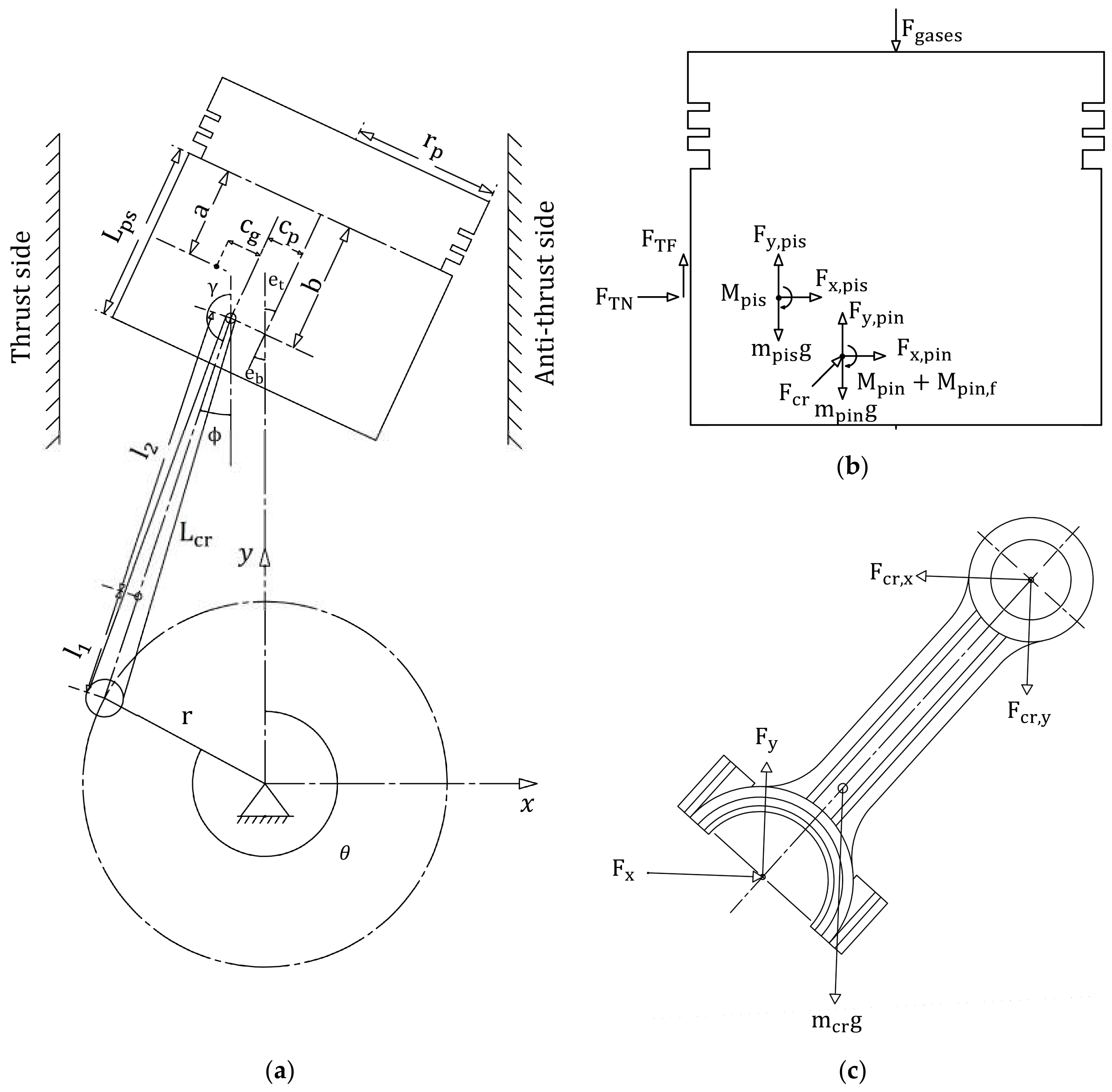
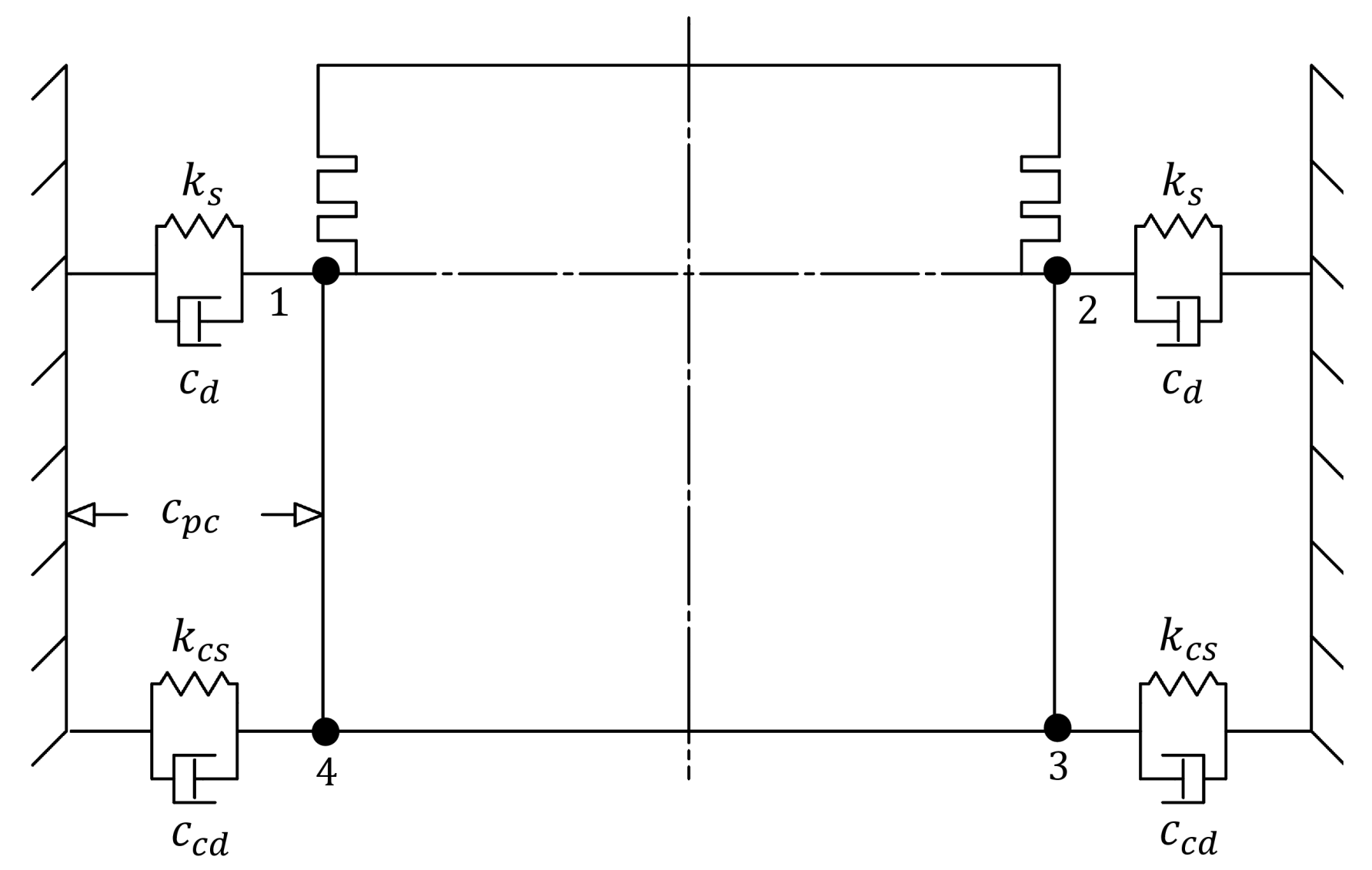
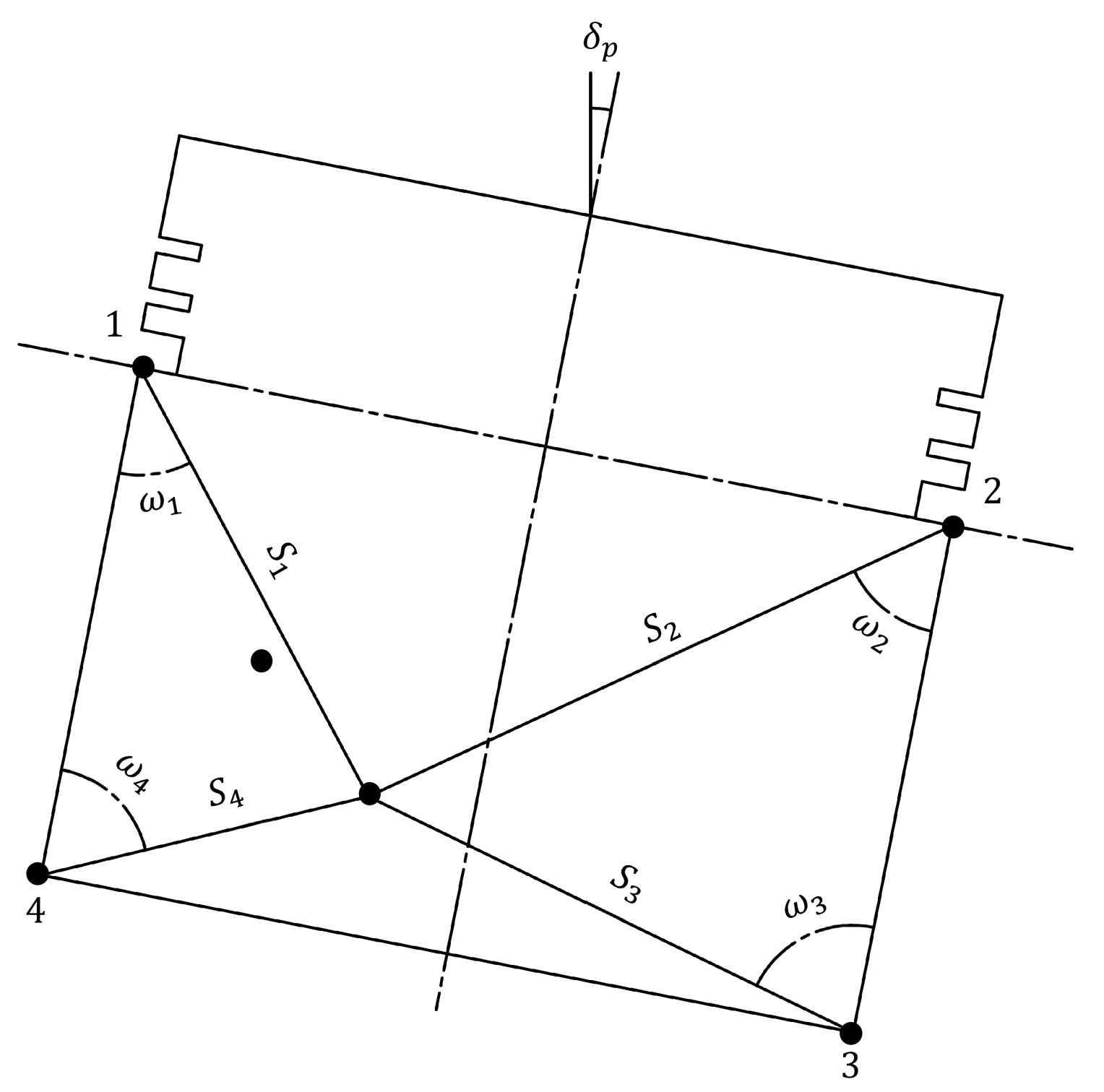
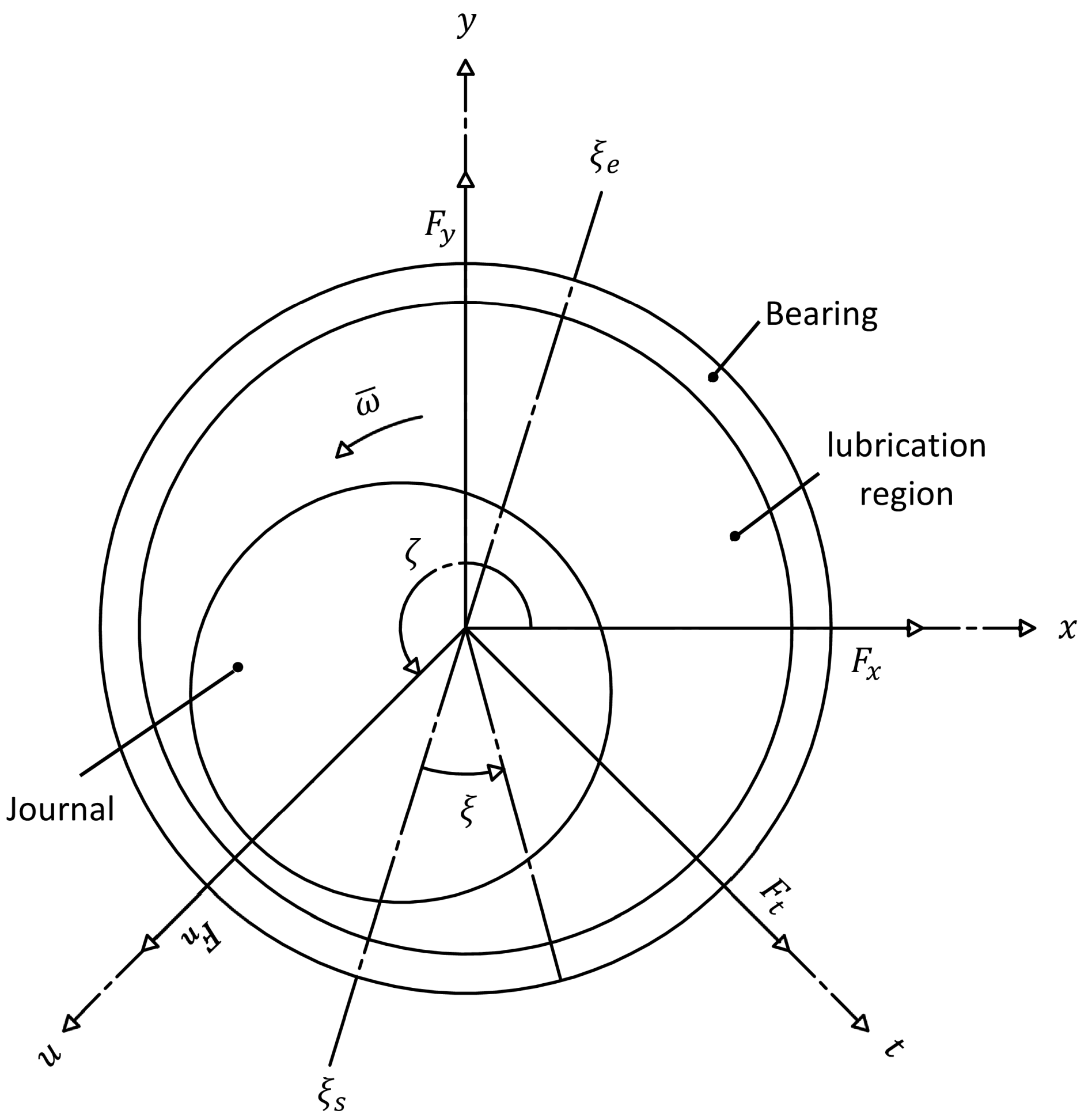
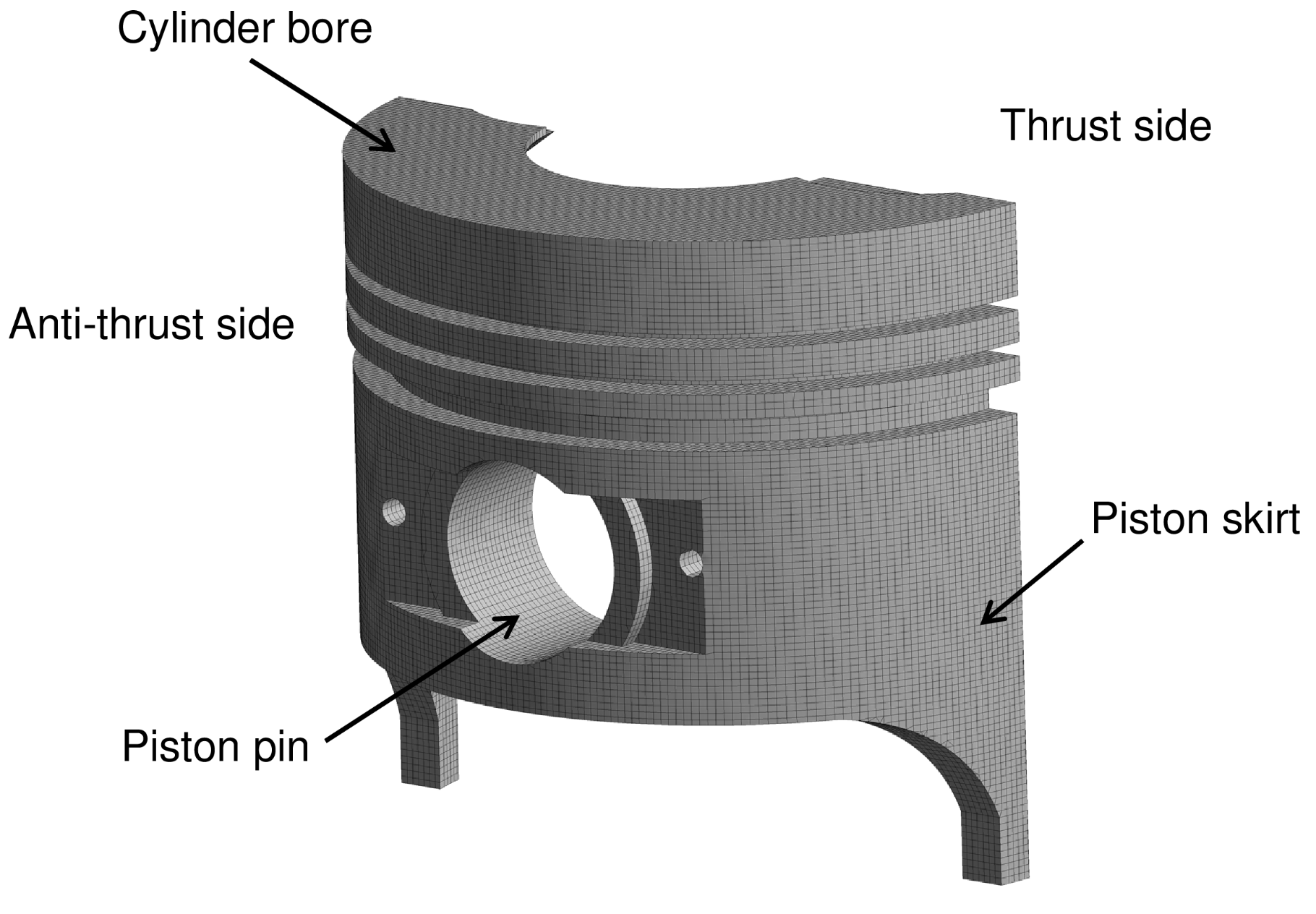

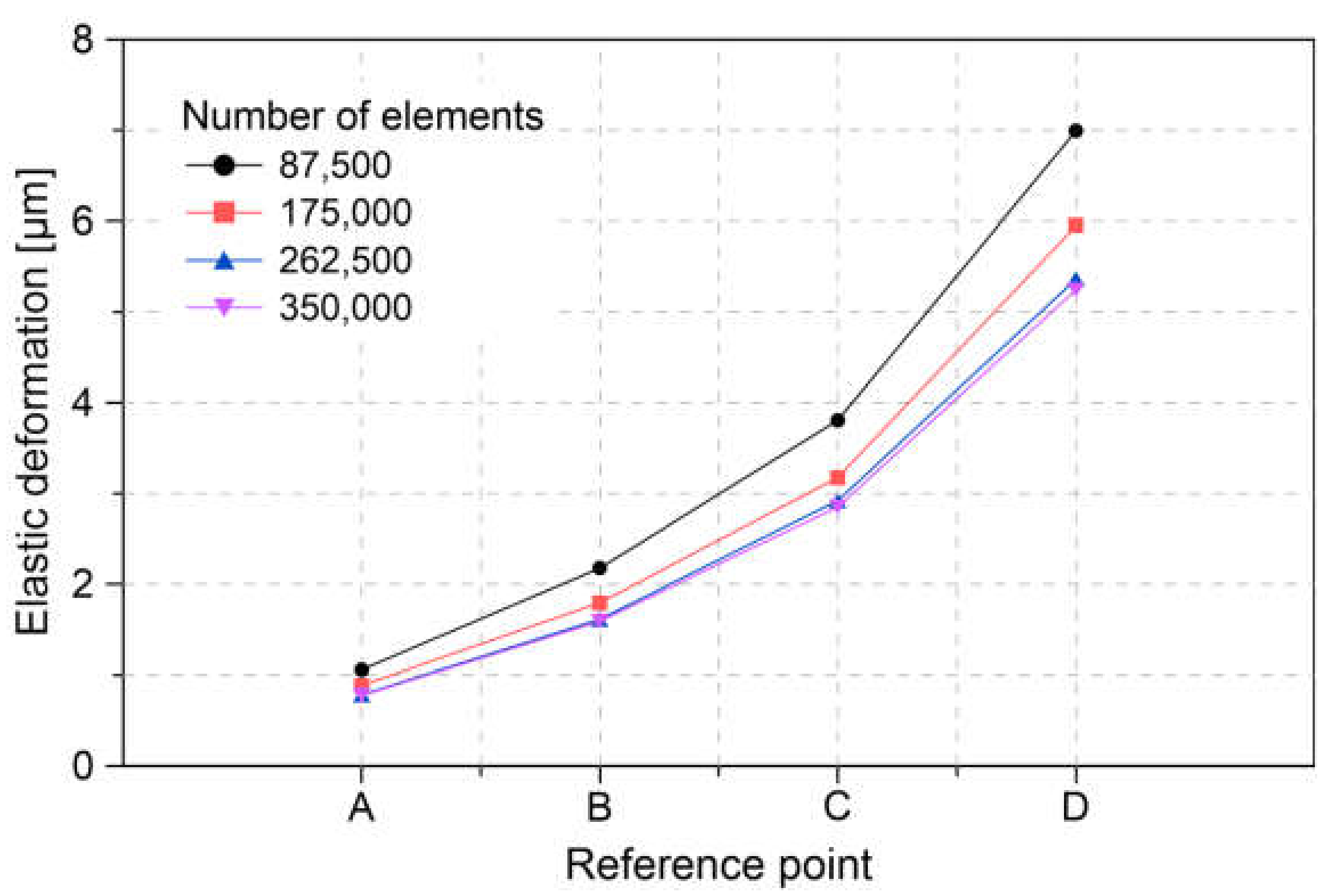
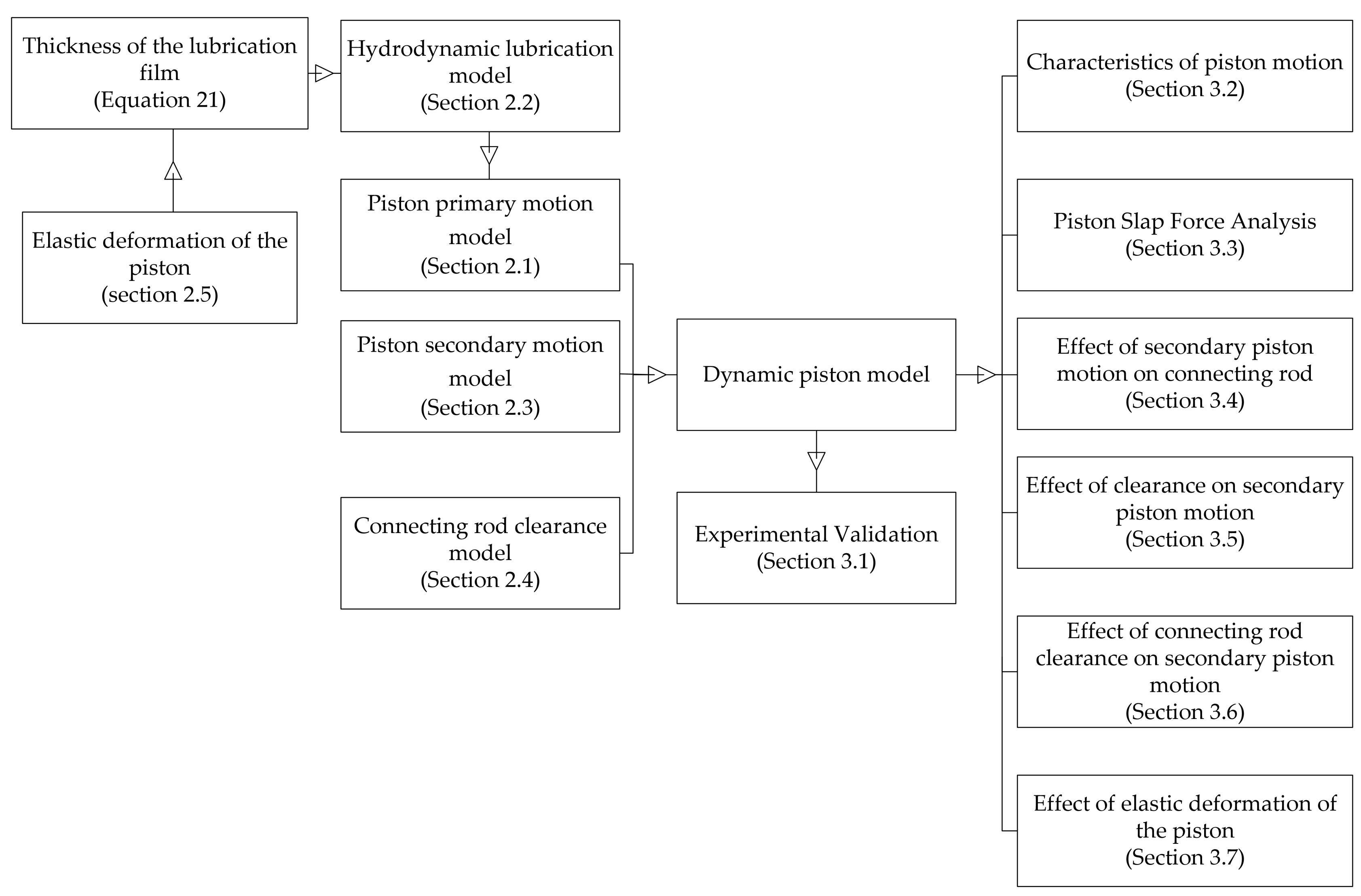
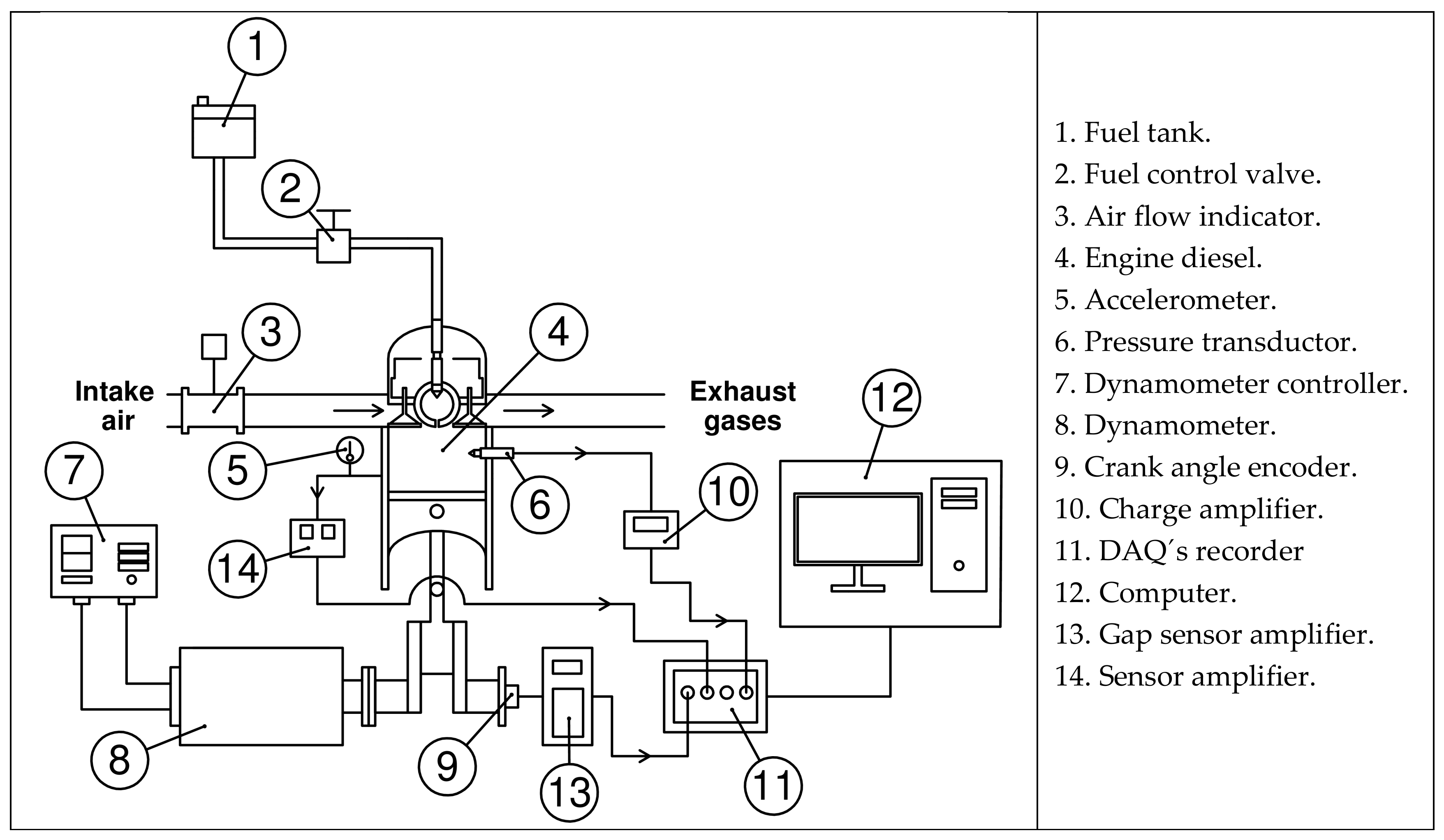
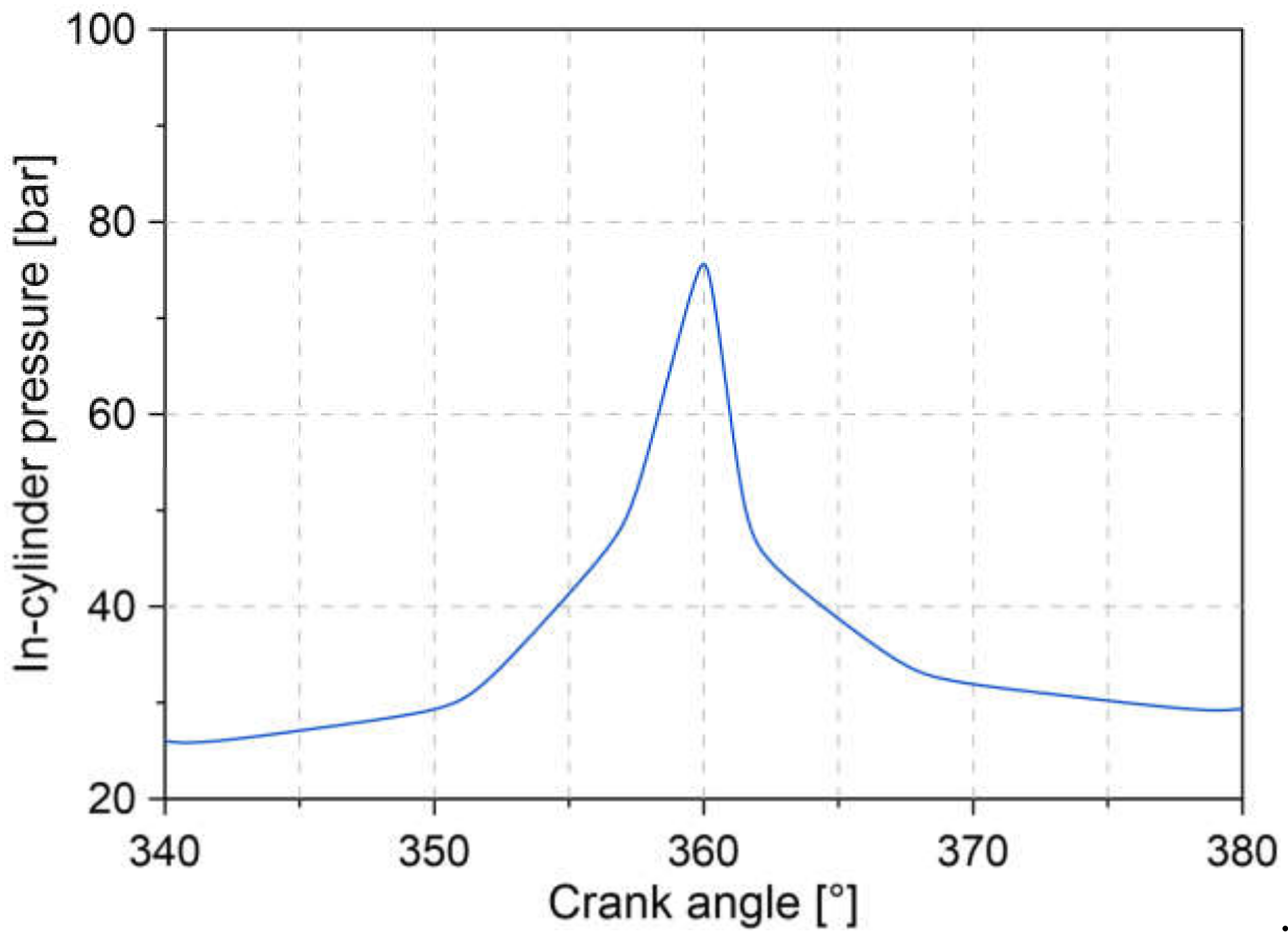
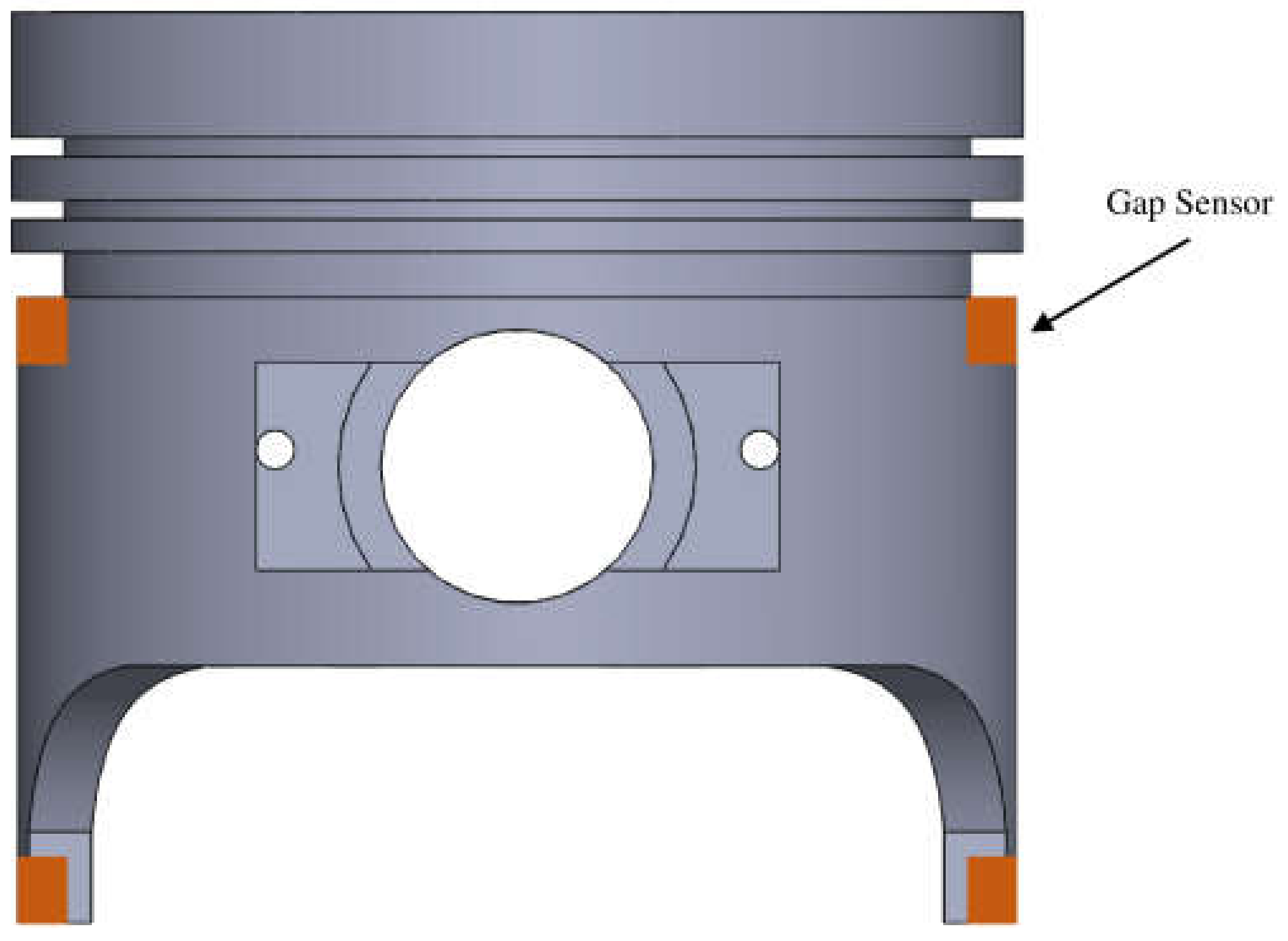
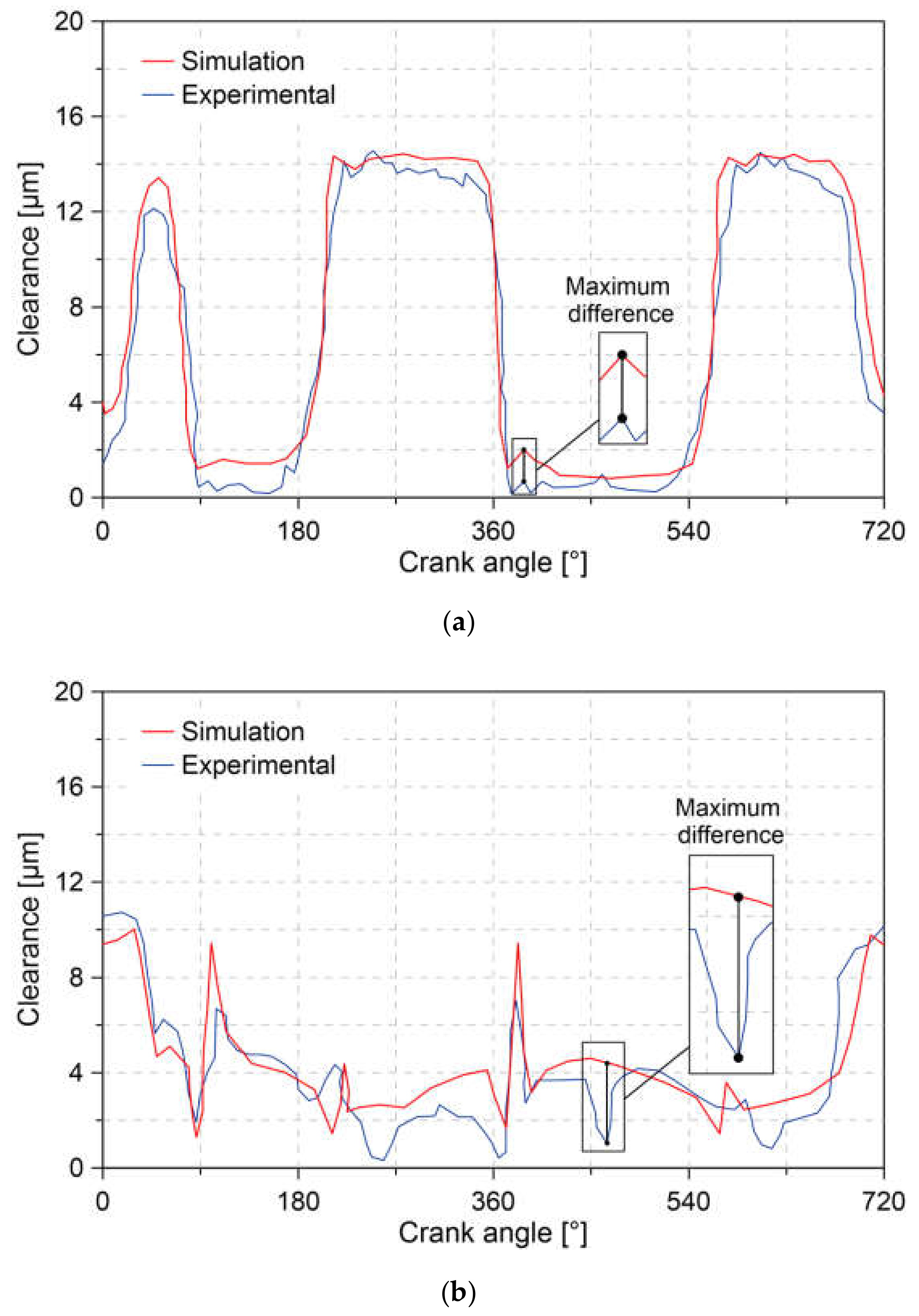
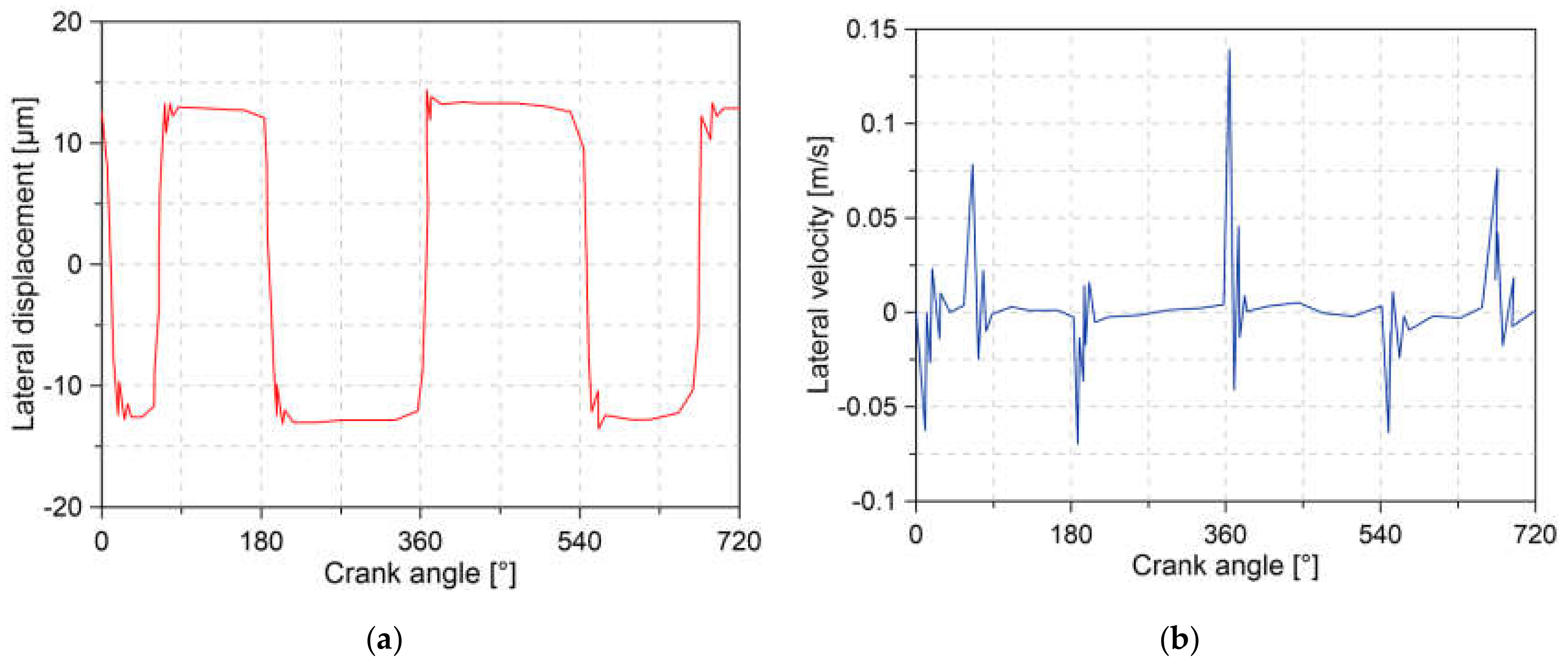
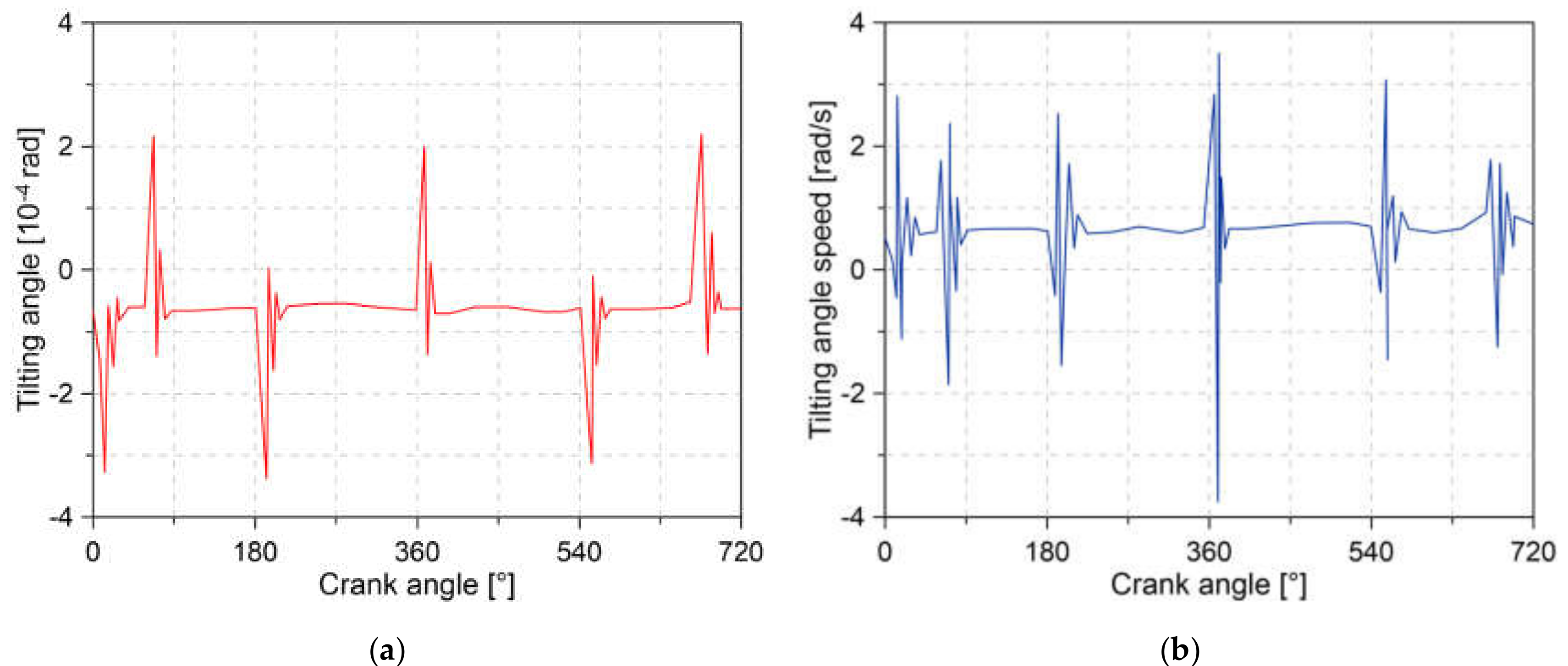
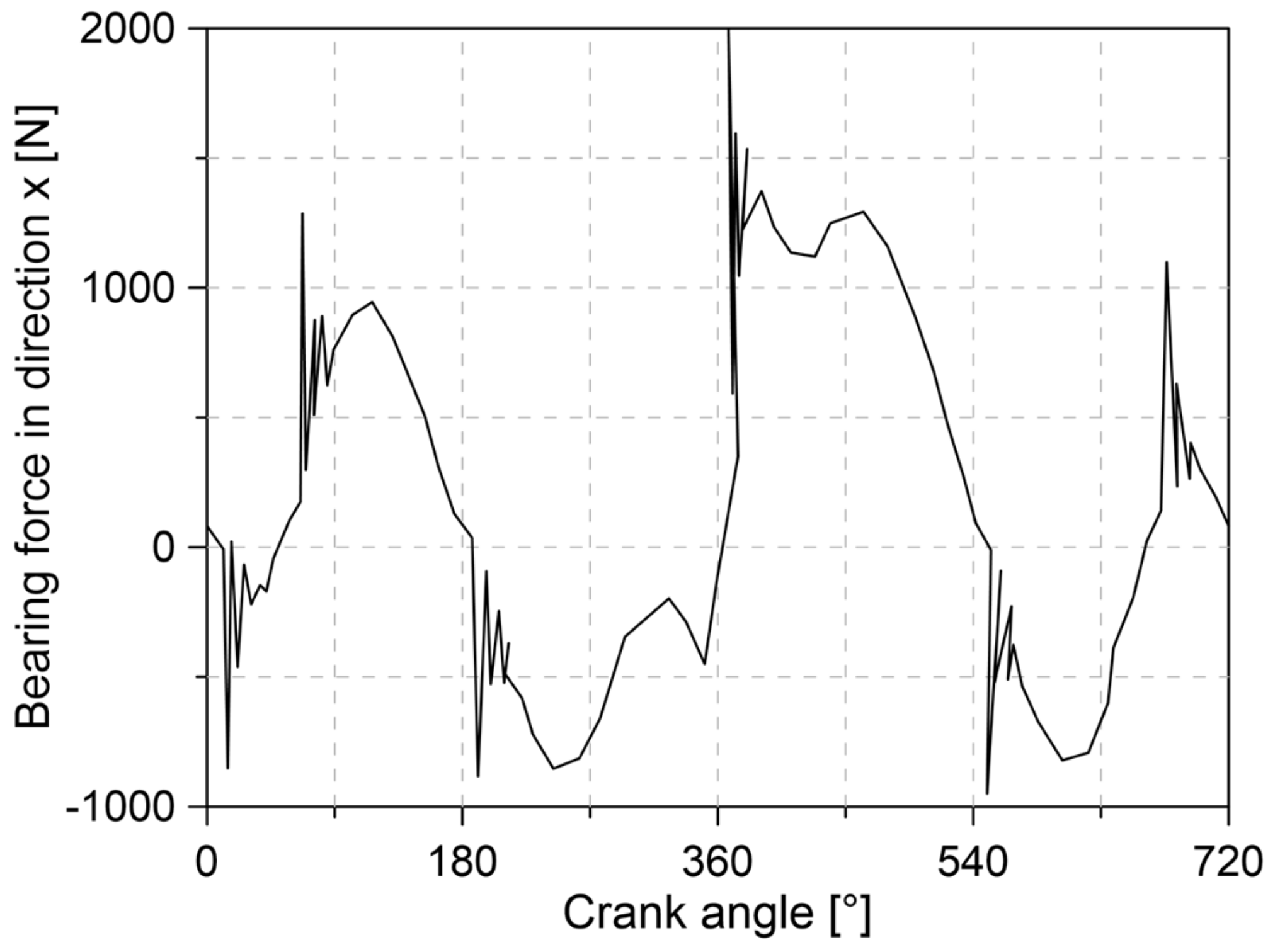
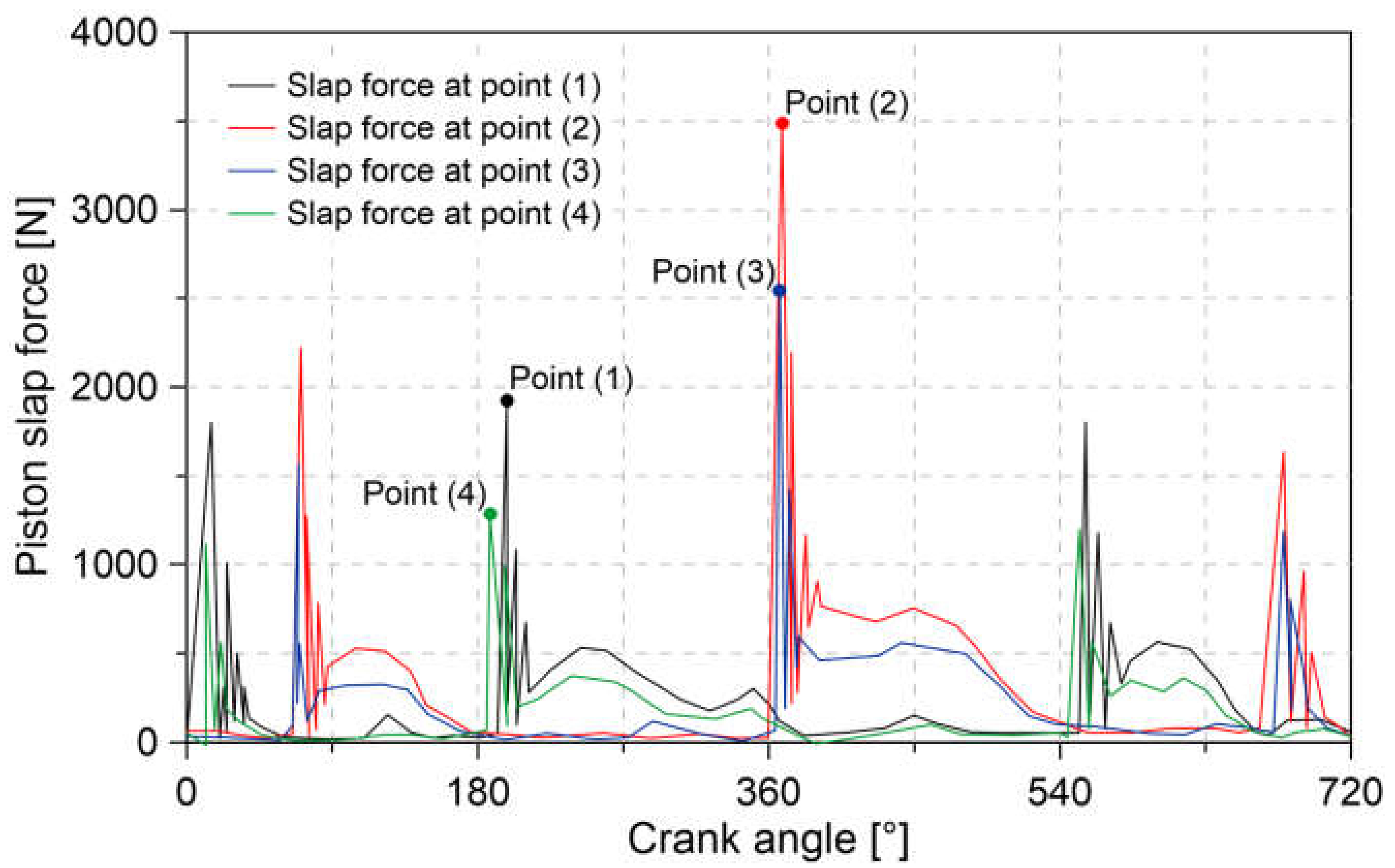
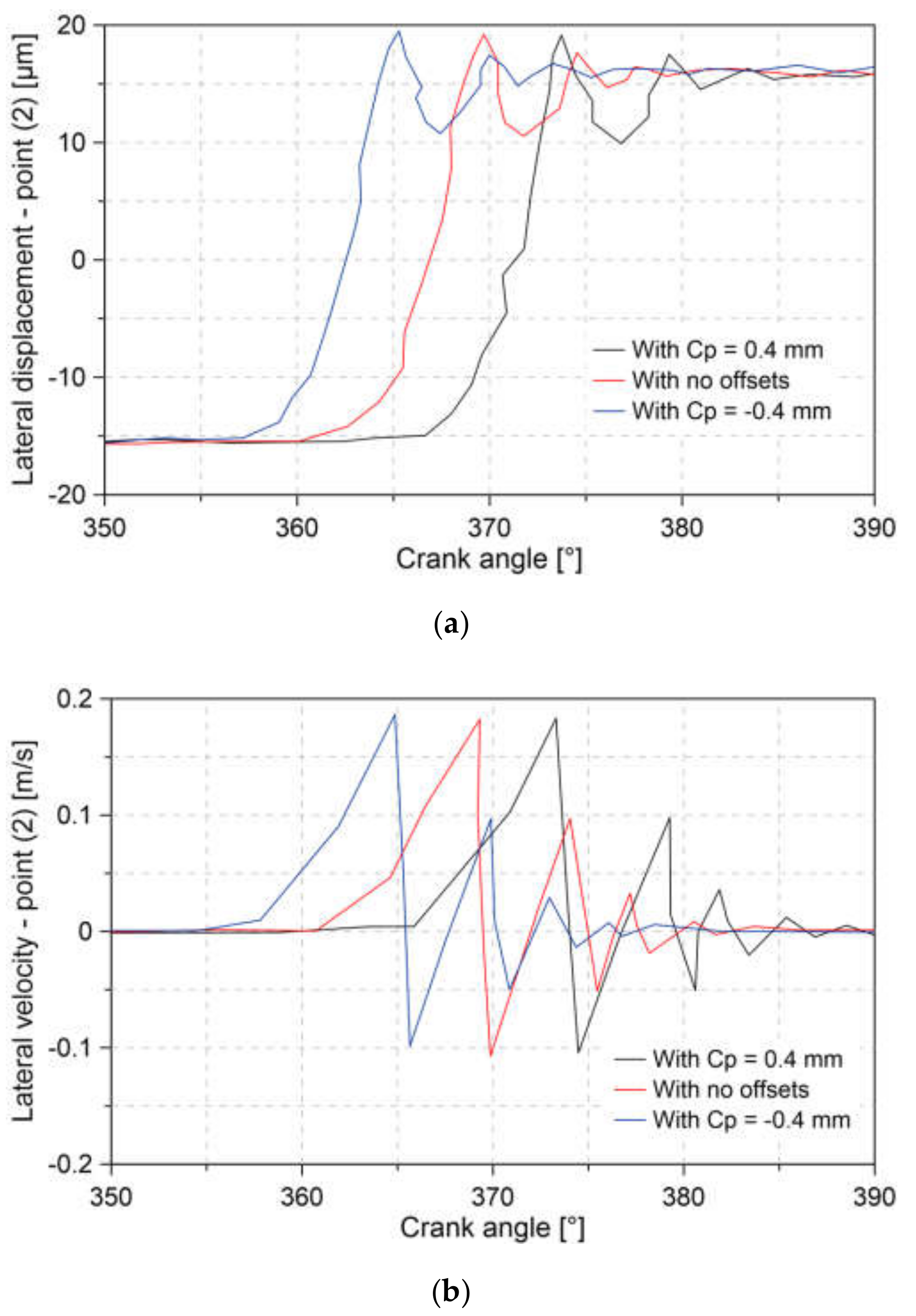
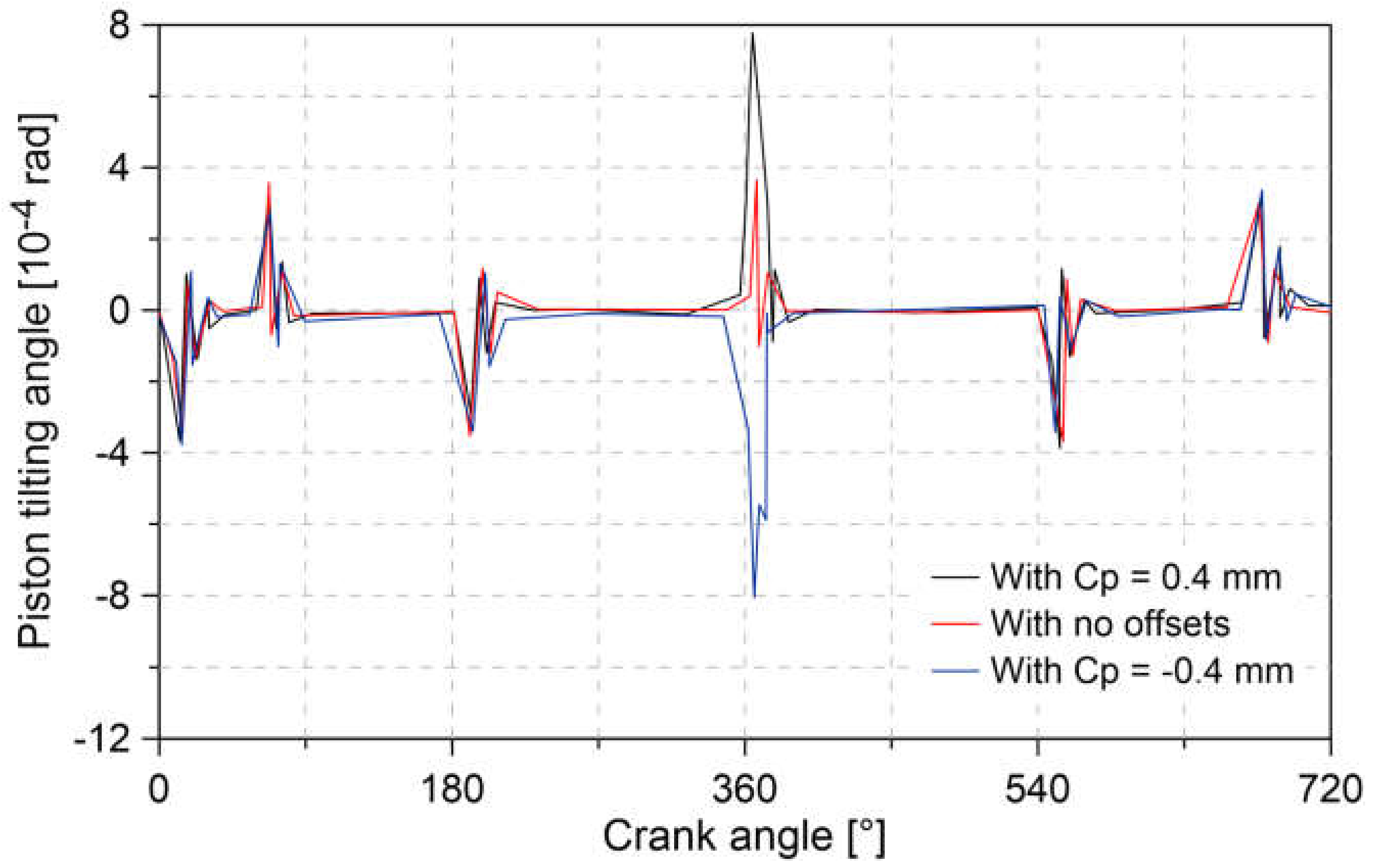
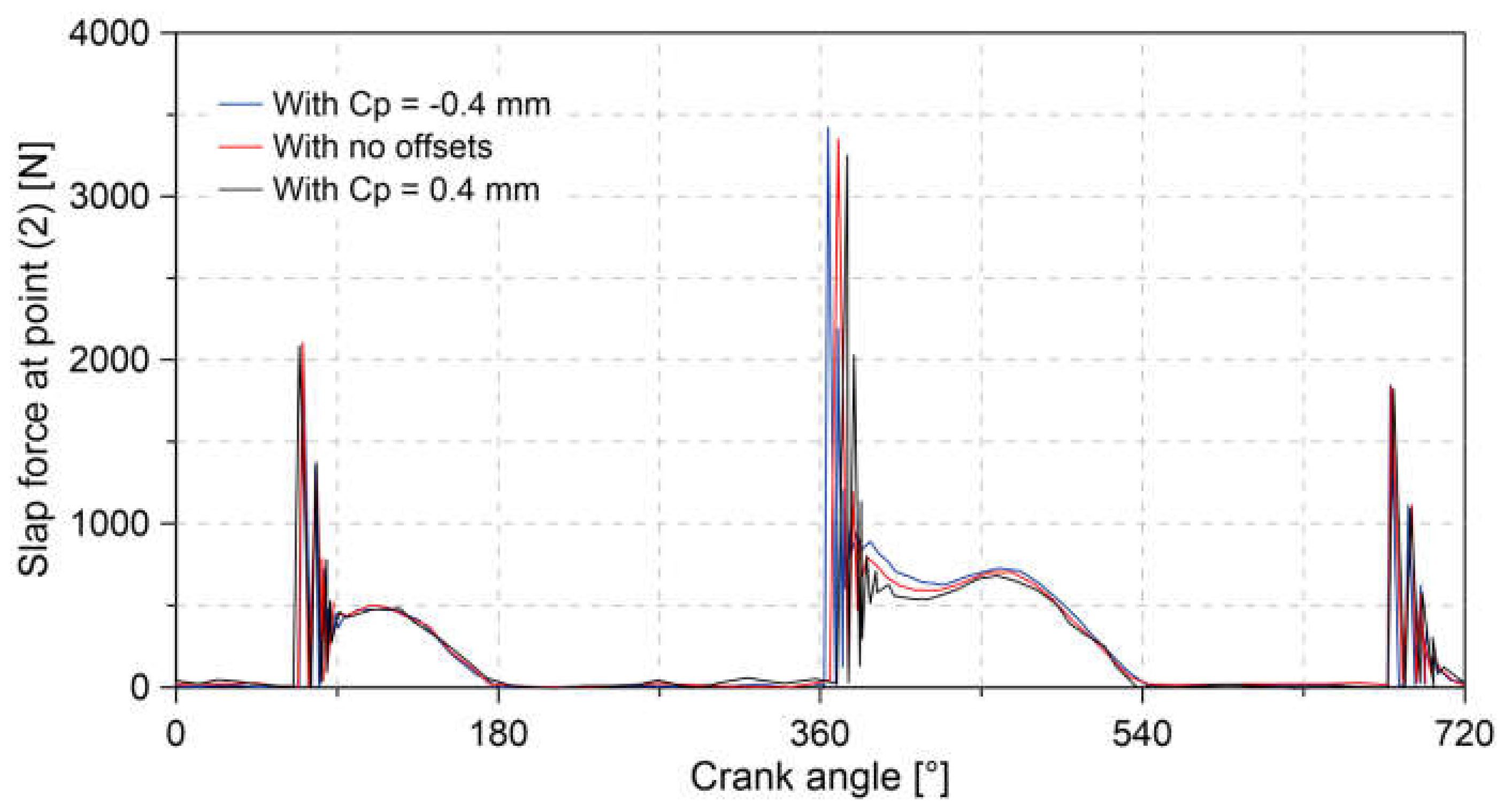

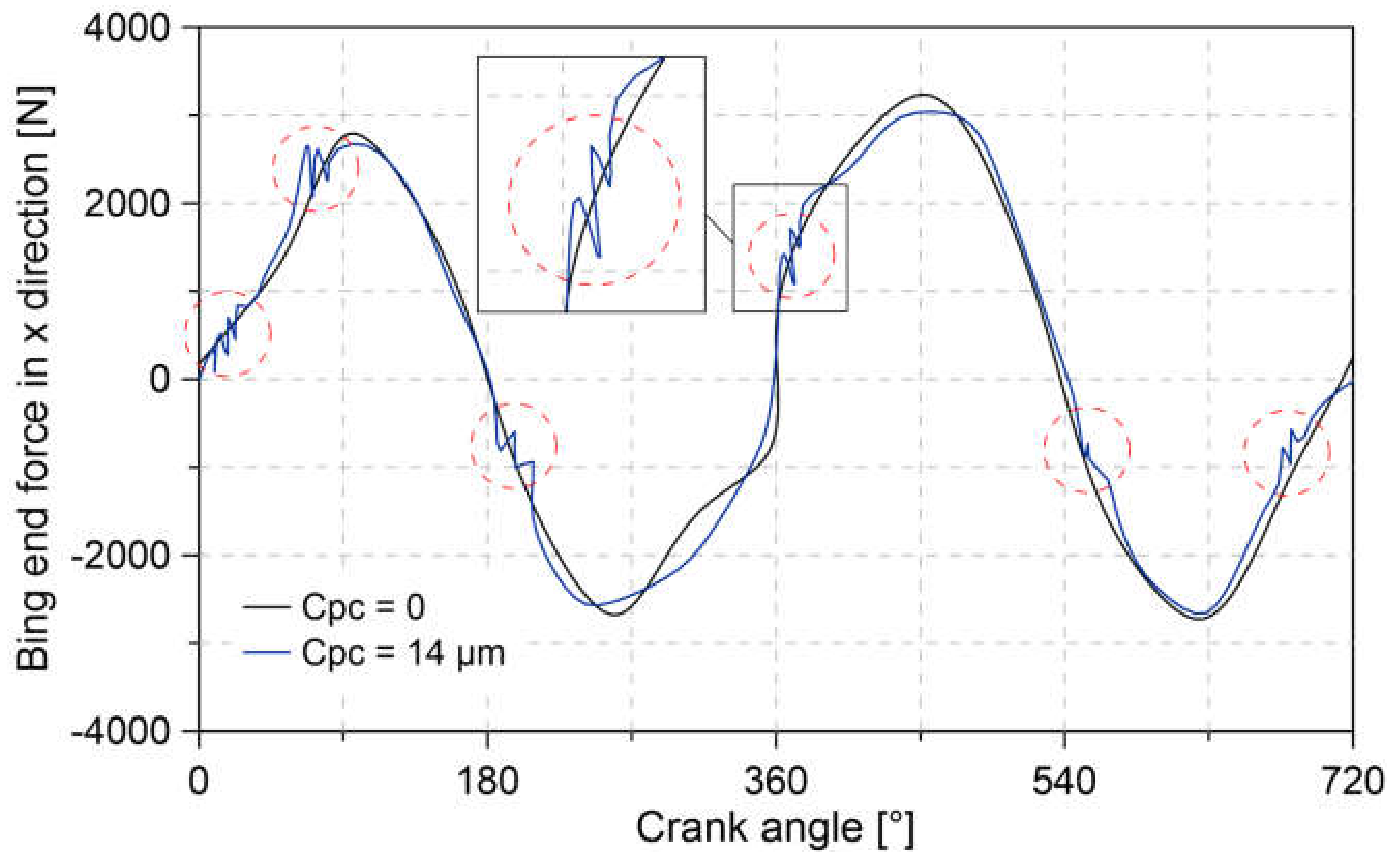
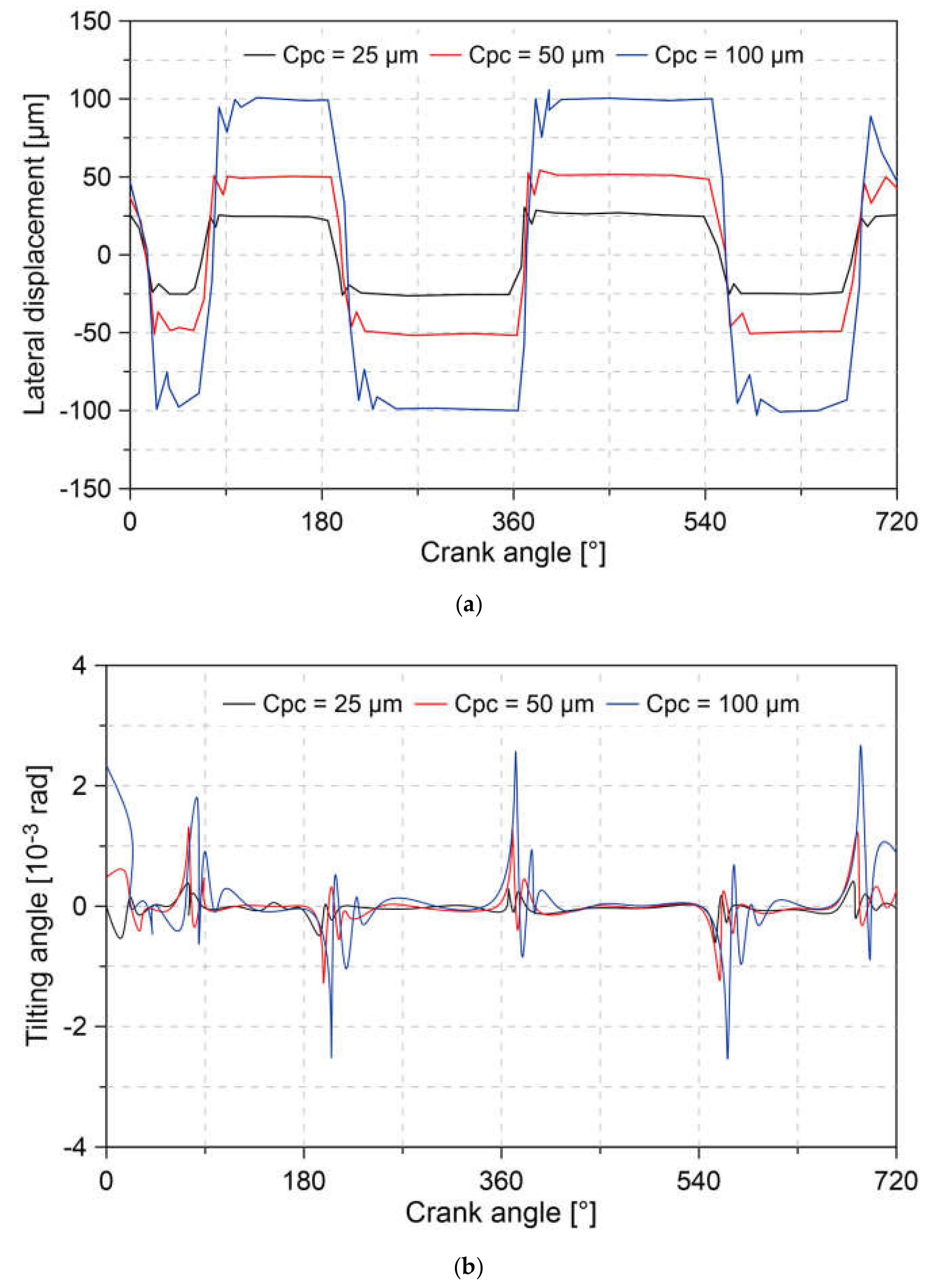
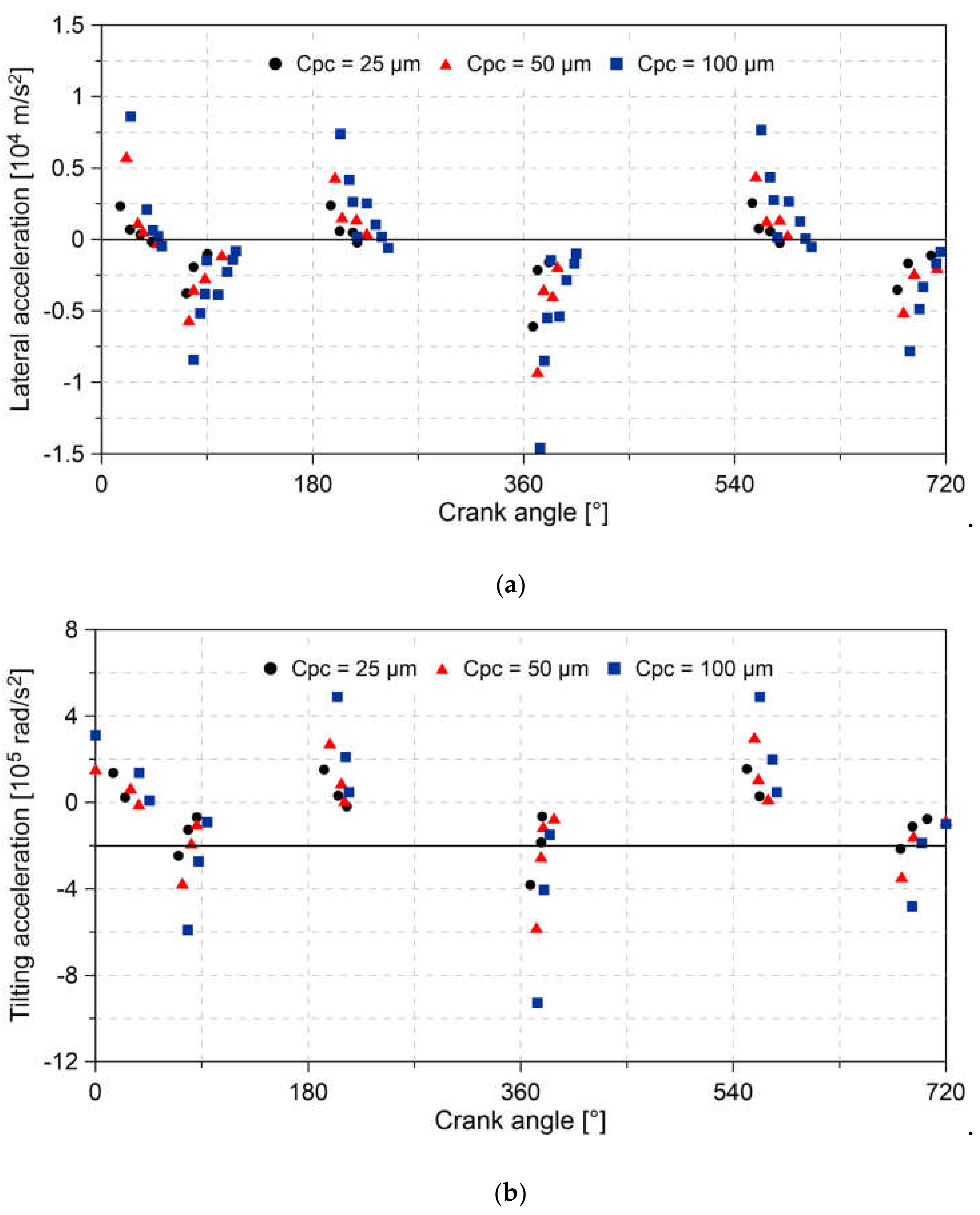
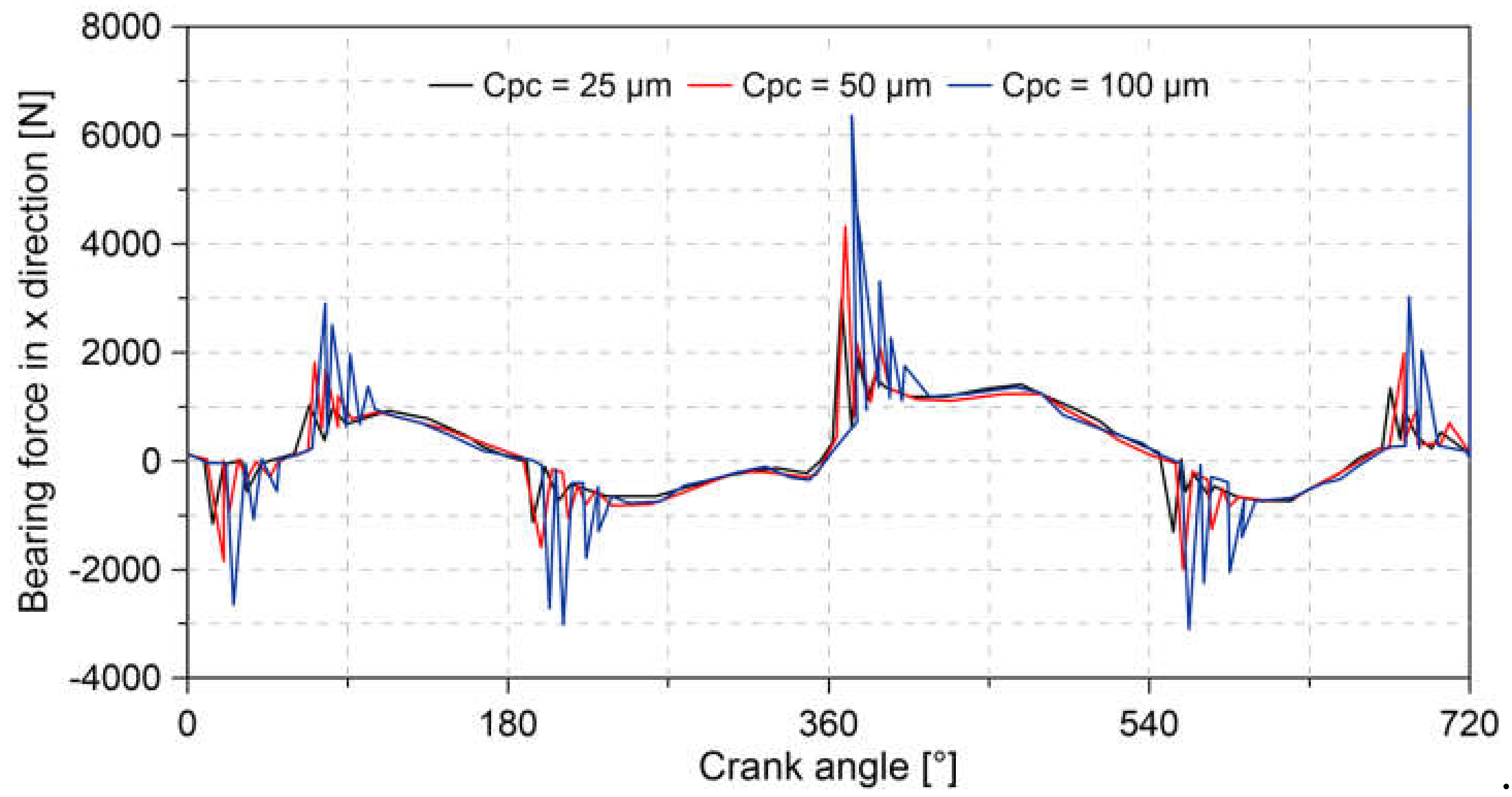
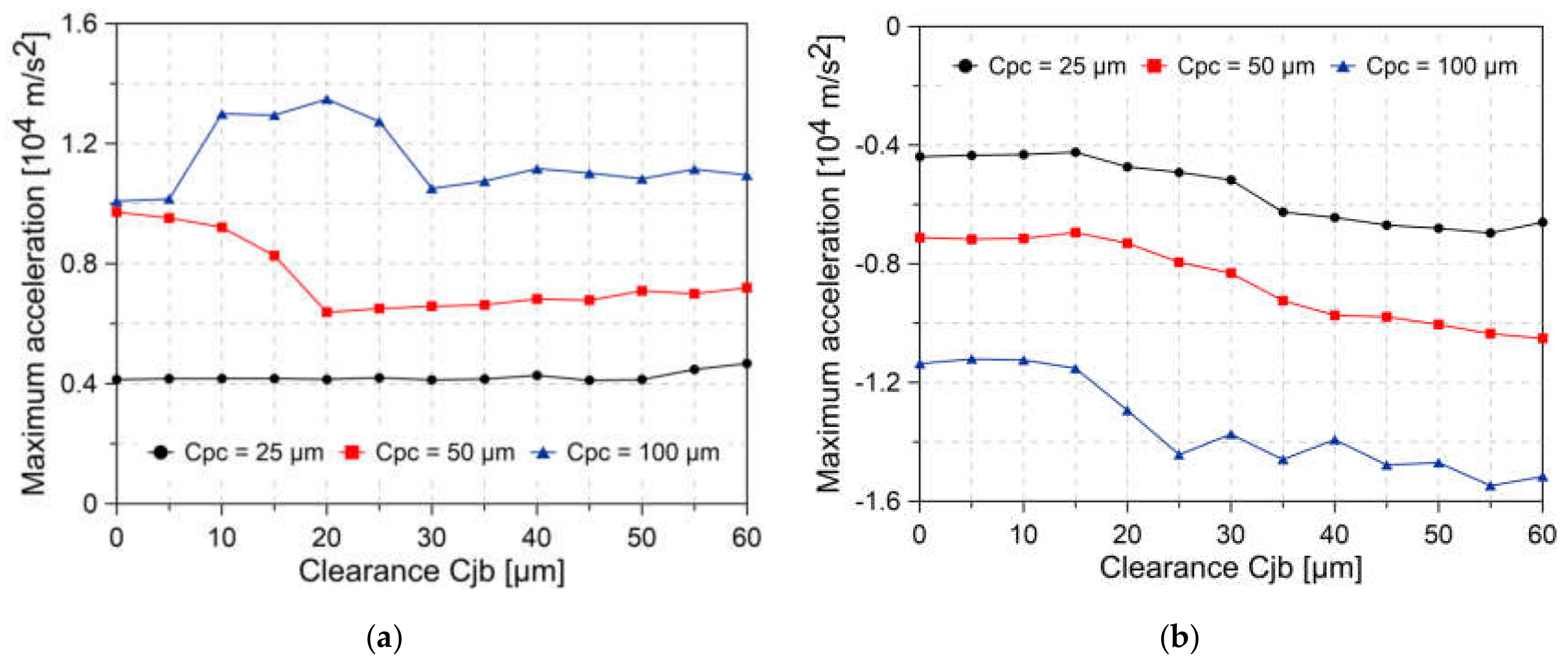
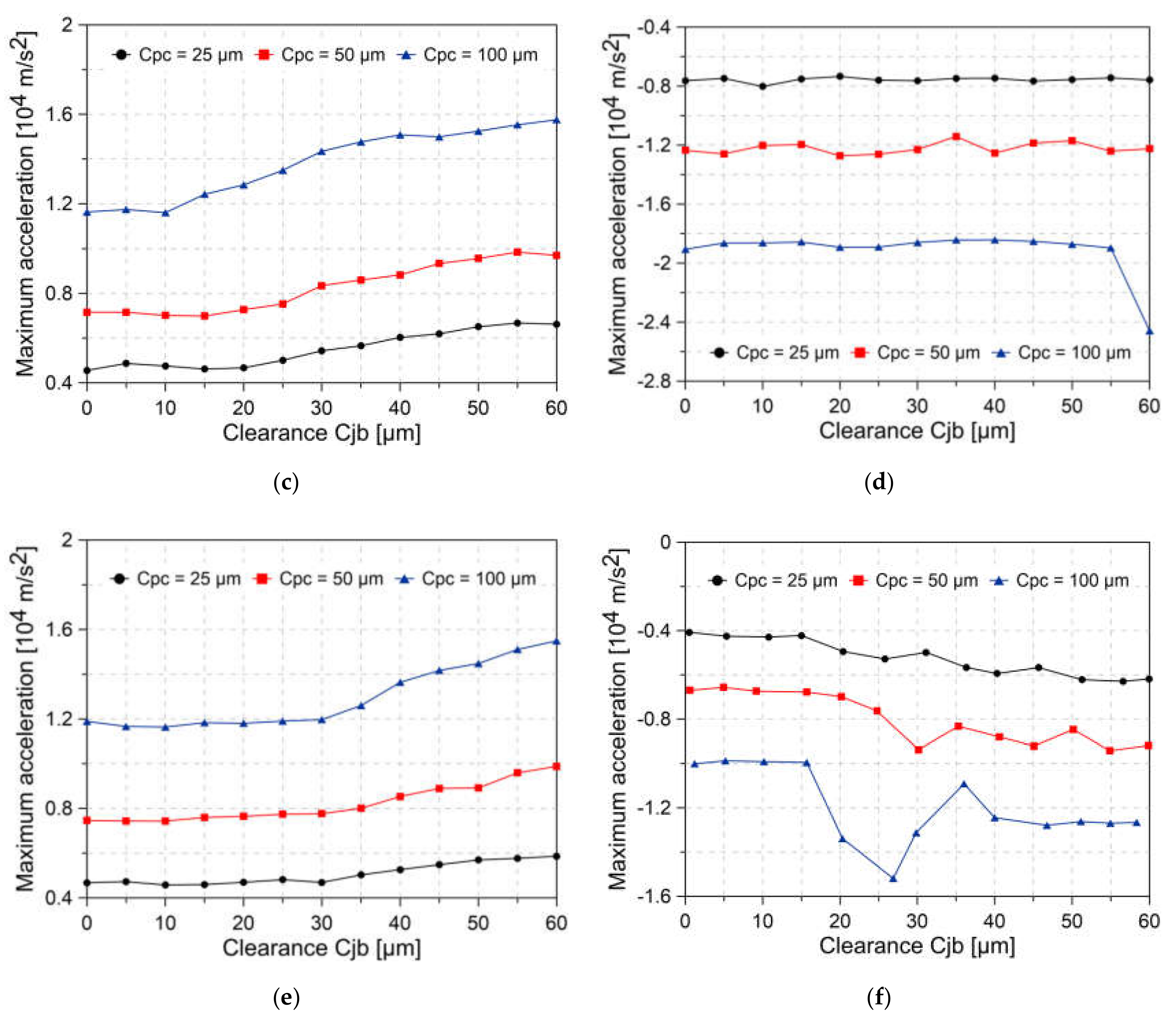

| Parameter | Value |
|---|---|
| Distance | 24 mm |
| Length of piston skirt | 48 mm |
| Distance | 35 mm |
| Crankshaft radius | 48 mm |
| Length of connecting rod | 106 mm |
| Distance | 28 mm |
| Distance | 78 mm |
| Piston radius | 39 mm |
| Model | SK-MDF300 |
|---|---|
| Manufacturer | SOKAN |
| Engine type | 1 cylinder |
| Bore x stroke | 78 mm × 62.57 mm |
| Cycle | 4 Strokes |
| Maximum power | 4.6 hp at 3600 rpm |
| Compression ratio | 20:1 |
| Injection system | Direct injection |
| Displaced volume | 299 CC |
| Intake system | Naturally Aspirated |
| Parameter | Instrument | Manufacturer | Range | Uncertainty (%) |
|---|---|---|---|---|
| Cylinder pressure | Piezoelectric transducer | KISTLER | 0–250 bar | ±0.5 |
| Angle | Crankshaft angle | Beck Arnley | 5–9999 RPM | ±1.0 |
| Clearance | Gap sensor | Capacitec | 0–2.5 mm | ±0.2 |
| Crankshaft Angle (°) | |||
|---|---|---|---|
| 0–45 | 40.24 | 19.87 | 4.82 |
| 45–90 | 14.86 | 15.16 | 15.11 |
| 180–270 | 19.92 | 14.90 | 9.71 |
| 540–630 | 30.12 | 25.19 | 24.89 |
| 630–720 | 15.20 | 15.07 | 15.11 |
| Acceleration (m/s2) | |||
|---|---|---|---|
| 0 | 180 | 270 | 300 |
| 5 | 259 | 299 | 339 |
| 10 | 198 | 268 | 318 |
| 15 | 307 | 308 | 408 |
| 20 | 277 | 417 | 1147 |
| 25 | 656 | 1336 | 1296 |
| 30 | 1015 | 1855 | 2335 |
| 35 | 1254 | 2034 | 2824 |
| 40 | 1323 | 2033 | 3063 |
| 45 | 1382 | 2332 | 3132 |
| 50 | 1402 | 2442 | 3262 |
| 55 | 1451 | 2451 | 3411 |
| 60 | 1530 | 2490 | 3410 |
Publisher’s Note: MDPI stays neutral with regard to jurisdictional claims in published maps and institutional affiliations. |
© 2020 by the authors. Licensee MDPI, Basel, Switzerland. This article is an open access article distributed under the terms and conditions of the Creative Commons Attribution (CC BY) license (http://creativecommons.org/licenses/by/4.0/).
Share and Cite
Forero, J.D.; Ochoa, G.V.; Alvarado, W.P. Study of the Piston Secondary Movement on the Tribological Performance of a Single Cylinder Low-Displacement Diesel Engine. Lubricants 2020, 8, 97. https://doi.org/10.3390/lubricants8110097
Forero JD, Ochoa GV, Alvarado WP. Study of the Piston Secondary Movement on the Tribological Performance of a Single Cylinder Low-Displacement Diesel Engine. Lubricants. 2020; 8(11):97. https://doi.org/10.3390/lubricants8110097
Chicago/Turabian StyleForero, Jorge Duarte, Guillermo Valencia Ochoa, and Wlamyr Palacios Alvarado. 2020. "Study of the Piston Secondary Movement on the Tribological Performance of a Single Cylinder Low-Displacement Diesel Engine" Lubricants 8, no. 11: 97. https://doi.org/10.3390/lubricants8110097
APA StyleForero, J. D., Ochoa, G. V., & Alvarado, W. P. (2020). Study of the Piston Secondary Movement on the Tribological Performance of a Single Cylinder Low-Displacement Diesel Engine. Lubricants, 8(11), 97. https://doi.org/10.3390/lubricants8110097








